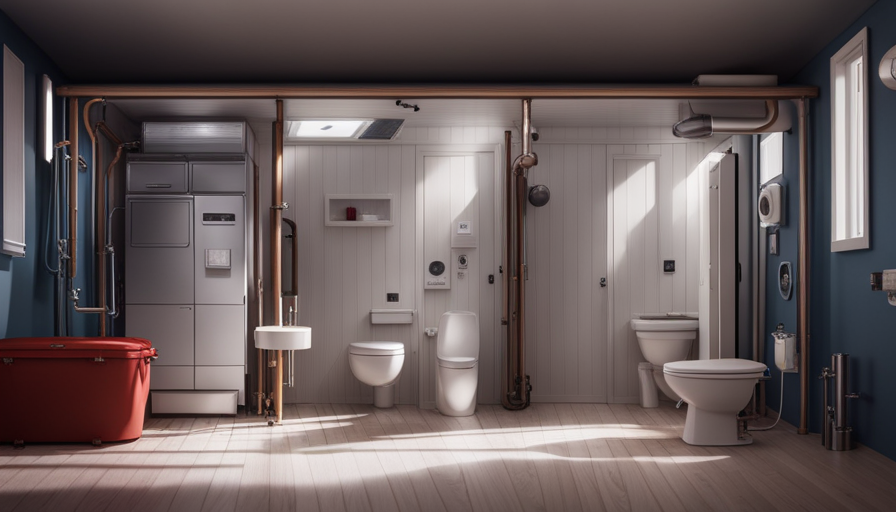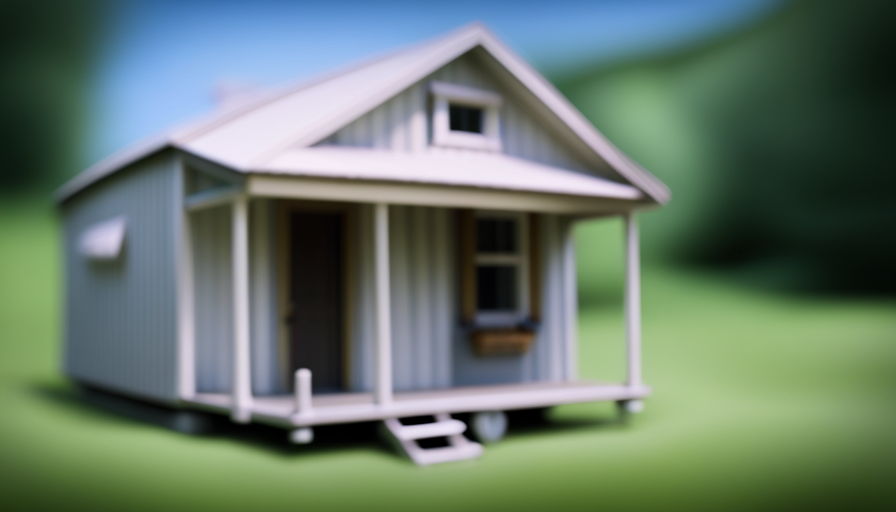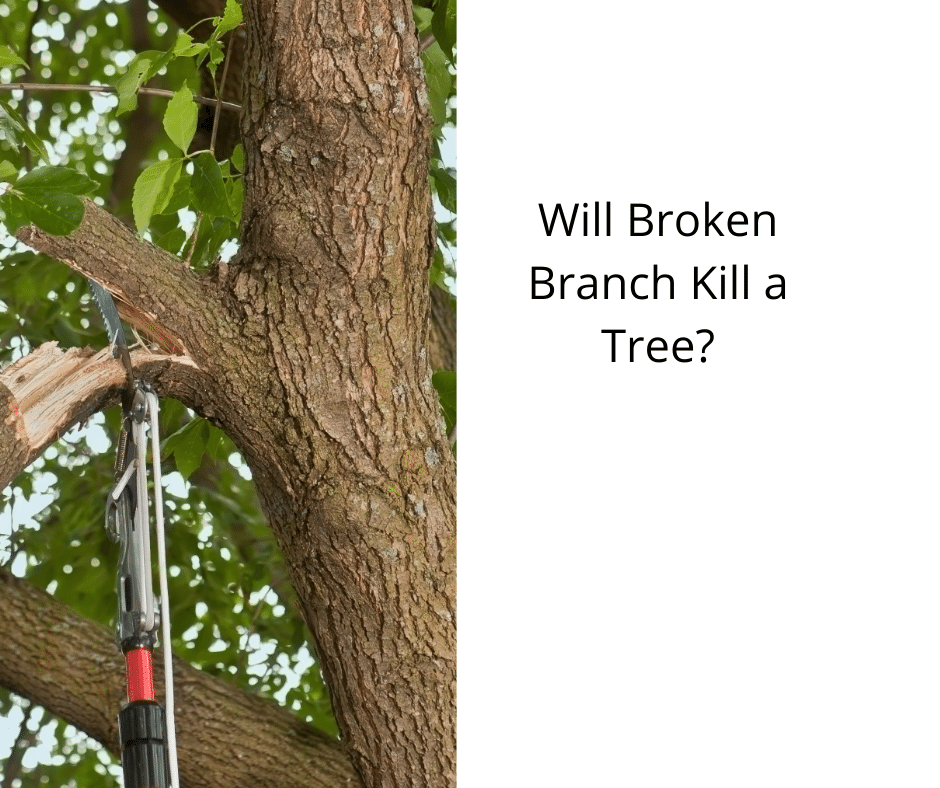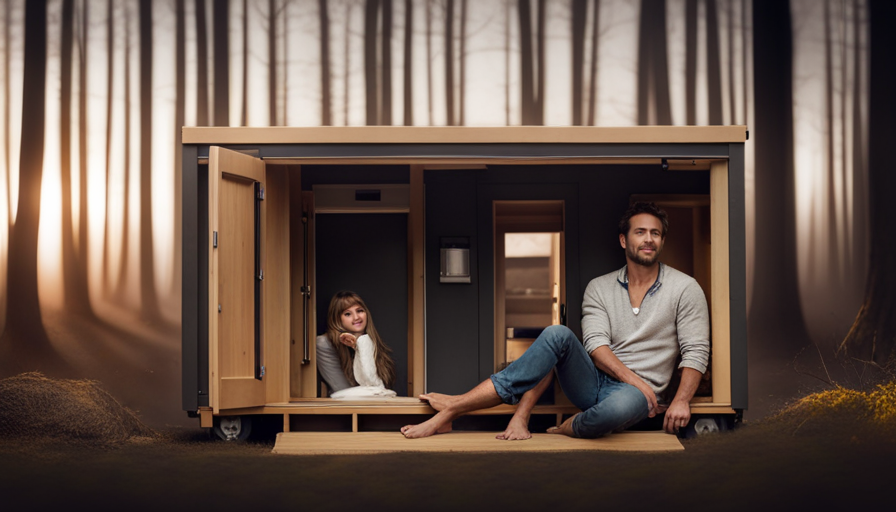Imagine living in a home where every corner is meticulously used, with a focus on efficiency and simplicity. Welcome to the world of tiny homes, where the plumbing system is a masterpiece of creativity and technological progress.
In this article, I will guide you through the intricate workings of how the plumbing works in a tiny house, unraveling the mysteries behind water supply, waste management, and designing a functional system within limited space. We will explore the ins and outs of plumbing installation, as well as the crucial aspects of maintaining and troubleshooting in this unique setting.
Additionally, we will delve into the importance of heating and insulation for the plumbing system and the various ways to power it. Lastly, I will shed light on the legal and code requirements that govern plumbing in tiny houses, and discuss the pros and cons of this fascinating way of life.
Get ready to embark on a journey into the world of tiny house plumbing!
Key Takeaways
- Plumbing in tiny houses requires careful consideration due to limited space and the need for efficient use of resources.
- Water supply and filtration systems, as well as waste management systems like composting toilets and greywater systems, are important components of plumbing in tiny houses.
- Designing a functional plumbing system for limited space involves using space-saving fixtures and appliances.
- It is important to hire a professional plumber for installation, as well as to adhere to legal requirements and plumbing codes for tiny houses.
Water Supply in Tiny Houses
Get ready to dive into the world of water supply in tiny houses and discover how the plumbing works its magic!
In a tiny house, water supply is a crucial aspect that requires careful consideration. One of the key components of the water supply system is water filtration. Due to limited space, it’s essential to install a compact and efficient water filtration system to ensure clean and safe drinking water. This system helps remove impurities, such as sediment, bacteria, and chemicals, providing you with fresh and healthy water.
Another vital element in the water supply system is water pressure. Maintaining adequate water pressure is essential for a seamless water flow throughout your tiny house. To achieve this, a pressure regulator can be installed to control the water pressure coming from the main water source. This ensures that the water pressure isn’t too low or too high, preventing any damage to the plumbing system.
As we transition into the subsequent section about waste management in tiny houses, it’s important to note that proper water supply is closely linked to efficient waste management. With a well-designed plumbing system, waste can be effectively managed and disposed of, ensuring the overall functionality of your tiny house.
Waste Management in Tiny Houses
To effectively manage waste in a small dwelling, it’s crucial to establish an efficient system for disposal and sanitation. In tiny houses, composting toilets and greywater systems are popular solutions.
Composting toilets are self-contained units that break down human waste into compost. They rely on natural processes, such as aerobic bacteria, to convert waste into a safe and odorless material. These toilets require little to no water, making them ideal for water conservation in tiny homes.
Greywater systems are another essential component of waste management in tiny houses. Greywater refers to the relatively clean wastewater from sources like sinks, showers, and washing machines. Instead of disposing of it into the sewage system, greywater can be collected, filtered, and reused for non-potable purposes like watering plants or flushing toilets. This not only reduces water consumption but also minimizes the strain on septic systems or sewage hookups.
In designing a functional plumbing system for limited space, it’s important to consider the specific needs and constraints of a tiny house. By carefully planning the placement of plumbing fixtures and utilizing compact and space-saving components, it’s possible to create an efficient and effective plumbing system that maximizes functionality while minimizing the use of resources.
Designing a Functional Plumbing System for Limited Space
When designing a functional plumbing system for limited space, there are two key points to consider: space-saving fixtures and appliances, and plumbing layout.
Space-saving fixtures and appliances, such as compact toilets and tankless water heaters, are essential in maximizing the available space.
Additionally, the plumbing layout must be carefully planned to ensure efficient water flow and waste removal, taking into account the limited space and potential constraints.
Space-saving fixtures and appliances
Space-saving fixtures and appliances are key to maximizing the functionality and efficiency of plumbing systems in a tiny house. When it comes to space-saving fixtures, compact toilets and sinks are essential. These fixtures are designed to minimize their footprint without sacrificing functionality. For instance, wall-mounted toilets take up less space compared to traditional floor-mounted ones.
Additionally, installing a small sink with a narrow profile can free up valuable counter space in the bathroom or kitchen. Efficient appliances are also crucial in a tiny house. Energy-efficient water heaters, such as tankless models, can save space while providing hot water on demand. Similarly, compact washing machines and dishwashers are designed to fit in tight spaces without compromising performance.
These space-saving fixtures and efficient appliances are essential components of a well-designed plumbing system in a tiny house, allowing for maximum functionality in limited space. As we move on to discussing plumbing layout and considerations, it’s important to consider how these fixtures and appliances can be strategically placed to optimize space and functionality.
Plumbing layout and considerations
Now, let’s dive into how you can strategically arrange your plumbing system to make the most of your limited space and ensure optimal functionality. When it comes to plumbing layout in tiny houses, careful consideration must be given to the choice of plumbing materials and the management of water pressure. Using flexible PEX pipes instead of traditional copper pipes can save valuable space as they can be easily bent and routed through tight areas. Additionally, utilizing manifold systems can help distribute water efficiently to different fixtures, reducing the need for extensive piping. It is crucial to maintain adequate water pressure in a tiny house, especially when multiple fixtures are being used simultaneously. Installing a pressure regulator and a water pump can help ensure consistent water flow and prevent damage to appliances. Proper plumbing layout and consideration of materials and water pressure are essential for an efficient and functional tiny house. In the next section, we will discuss the installation process for plumbing in tiny houses.
Plumbing Installation in Tiny Houses
When it comes to plumbing installation in tiny houses, hiring a professional plumber can be a wise decision. They have the expertise and knowledge to navigate the challenges of limited space and ensure that the plumbing system is installed correctly.
However, if you’re feeling confident and have some experience with plumbing, there are DIY tips you can follow to tackle the installation yourself. Just make sure to research and plan thoroughly to avoid any costly mistakes.
Hiring a professional plumber
To ensure smooth sailing in your tiny house, you’ll need to bring in a skilled plumber who can navigate the intricate plumbing system like a seasoned captain steering a ship through treacherous waters.
Hiring a plumber for your tiny house may seem like an added expense, but the benefits far outweigh the cost. A professional plumber has the expertise and knowledge to properly install and connect all the necessary plumbing fixtures, ensuring they meet building codes and regulations. They can also help you choose the right materials and equipment for your specific needs, avoiding costly mistakes.
Additionally, a professional plumber can provide valuable advice on maintenance and troubleshooting, saving you time and headaches down the road.
Now, let’s dive into some DIY plumbing installation tips to complement the work of your hired professional.
DIY plumbing installation tips
Get ready to feel empowered as you tackle the installation of your very own plumbing system in your cozy home-on-wheels! When it comes to DIY plumbing in a tiny house, there are a few important factors to consider. First, you need to ensure proper water pressure in your system. This can be achieved by installing a pressure regulator, which will help prevent any potential damage to your pipes and fixtures. Additionally, choosing the right plumbing materials is crucial. Opt for materials such as PEX or CPVC pipes, as they are flexible, lightweight, and resistant to freezing temperatures. To help you visualize the process, here’s a handy table outlining the materials you’ll need for each aspect of your plumbing system:
| Aspect | Materials |
|---|---|
| Water supply | PEX or CPVC pipes |
| Drainage system | PVC pipes |
| Fixtures | Faucets, toilets, showers, etc. |
By following these tips and using the right materials, you can confidently install your own plumbing system in your tiny house. Now, let’s move on to maintaining and troubleshooting your plumbing system without missing a beat.
Maintaining and Troubleshooting Plumbing in Tiny Houses
If you want to ensure that your tiny house always has running water and a properly functioning plumbing system, it’s crucial to understand how to maintain and troubleshoot it effectively. Here are some tips to help you maintain your plumbing fixtures and troubleshoot water pressure issues:
-
Regularly clean and inspect your plumbing fixtures, such as faucets and showerheads, to remove mineral buildup and debris that can affect water flow.
-
Check for leaks by inspecting all visible pipes and connections. Even a small leak can waste a significant amount of water and lead to more serious problems if left untreated.
-
Maintain proper water pressure by checking the pressure regulator and adjusting it if necessary. Low water pressure can be caused by a faulty regulator or clogged pipes.
-
If you’re experiencing inconsistent water pressure, it could be due to a clogged aerator or a problem with the pressure tank. Clean or replace the aerator and check the pressure tank for any issues.
-
If you’re unable to identify or resolve plumbing issues on your own, don’t hesitate to seek professional help.
By properly maintaining your plumbing fixtures and troubleshooting water pressure problems, you can ensure a reliable water supply in your tiny house.
Next, let’s explore water conservation in tiny houses.
Water Conservation in Tiny Houses
Save water and reduce your environmental impact by implementing water conservation practices in your compact dwelling. In a tiny house, every drop counts, so it’s important to be mindful of your water usage. By adopting simple techniques and utilizing efficient fixtures, you can significantly minimize your water consumption.
One effective way to conserve water is by managing gray water. Gray water is the used water from sinks, showers, and laundry machines, which can be reused for purposes other than drinking, such as watering plants or flushing toilets. Implementing a gray water system can help you maximize water conservation in your tiny house.
To give you a better idea of how much water you can save, here’s a table showcasing the average water usage for common activities in a typical household:
| Activity | Average Water Usage |
|---|---|
| Shower (10 minutes) | 25 gallons |
| Toilet Flush | 1.6 gallons |
| Dishwasher | 6 gallons |
By incorporating a gray water management system, you can reduce your water consumption by reusing this water for non-potable purposes. This not only conserves water but also reduces the strain on your plumbing system.
Transitioning to the next section about ‘heating and insulation for plumbing in tiny houses’, it’s important to ensure that your tiny house is equipped with proper heating and insulation to prevent freezing and damage to the plumbing system.
Heating and Insulation for Plumbing in Tiny Houses
Now that we’ve covered the importance of water conservation in tiny houses, let’s move on to the next crucial aspect of plumbing in these compact spaces: heating and insulation.
Ensuring that the plumbing system is properly heated and insulated is essential to prevent freezing and maintain a constant water temperature.
When it comes to heating system options for tiny houses, there are a few common choices. One option is to use an on-demand water heater, which provides hot water instantly and eliminates the need for a storage tank. Another option is to install a small, energy-efficient water heater specifically designed for tiny houses. These heaters are compact and can be easily integrated into the limited space available.
In terms of insulation, choosing the best materials is crucial to prevent heat loss and keep the plumbing system functioning optimally. Some popular insulation materials for tiny house plumbing include closed-cell foam insulation, which provides excellent thermal resistance, and pipe insulation sleeves, which are specifically designed to wrap around pipes and prevent heat loss.
Proper heating and insulation are vital for the plumbing system in tiny houses to function effectively and efficiently.
Now that we’ve covered this aspect, let’s delve into the next step of powering the plumbing system in these compact dwellings.
Powering the Plumbing System in Tiny Houses
To ensure a reliable and efficient plumbing system in compact dwellings, it’s important to consider the power source that will support the system’s functionality. In tiny houses, the power source for the plumbing system typically comes from a combination of electricity and propane. Electricity powers the water pump, while propane is used to heat the water. This combination allows for a consistent and efficient flow of water throughout the house.
One key aspect to consider when powering the plumbing system in tiny houses is the water pressure. Since these dwellings have limited space, it’s crucial to have a system that can provide sufficient water pressure for everyday tasks such as showering and washing dishes. To achieve this, a pressure regulator is often installed to ensure that the water pressure remains at a safe and optimal level.
To better understand the power source and water pressure in tiny house plumbing systems, refer to the following table:
| Power Source | Water Pump | Water Heater |
|---|---|---|
| Electricity | Yes | No |
| Propane | No | Yes |
Understanding the power source and water pressure is essential for designing and maintaining an efficient plumbing system in tiny houses. However, it’s also crucial to be aware of the legal and code requirements for plumbing in these dwellings, which will be discussed in the next section.
Legal and Code Requirements for Plumbing in Tiny Houses
Ensure that you understand the legal requirements and plumbing codes for compact dwellings to avoid any complications or issues in the future. When it comes to plumbing in tiny houses, there are specific regulations that you must adhere to.
These requirements vary depending on the location and jurisdiction, so it’s crucial to research and comply with the applicable codes.
Legal requirements for plumbing in tiny houses typically involve the installation of proper waste disposal systems, including toilets, sinks, and showers. Additionally, there may be specifications regarding water supply connections, such as the type of pipes used and the location of shut-off valves. It’s important to consult with local authorities or a professional plumber to ensure compliance with these regulations.
Plumbing codes for tiny houses are designed to ensure the safety and functionality of the plumbing system. They cover various aspects, including the size and layout of plumbing fixtures, proper venting, and the prevention of cross-contamination between potable and non-potable water sources. These codes also address issues such as drainage, water pressure, and backflow prevention.
Understanding and following the legal requirements and plumbing codes for tiny houses is crucial to avoid potential legal issues and ensure a properly functioning plumbing system. By adhering to these regulations, you can enjoy the benefits of a well-designed and efficient plumbing system in your tiny house.
Now, let’s explore the pros and cons of tiny house plumbing.
Pros and Cons of Tiny House Plumbing
With its compact size and efficient design, plumbing in a tiny home can be both a blessing and a curse, like a double-edged faucet. While the limited space can make plumbing installation and maintenance easier, it also presents challenges that need to be considered.
Here are three key factors to keep in mind when it comes to plumbing in a tiny house:
-
Water Pressure: Due to the smaller size of the plumbing system, maintaining adequate water pressure can be a challenge. It’s important to choose fixtures and appliances specifically designed for low water pressure to ensure a comfortable and functional water flow.
-
Cost Considerations: Plumbing in a tiny house can be cost-effective compared to traditional homes. With fewer fixtures and less piping, the initial installation cost is generally lower. Additionally, the smaller volume of water used in a tiny house can result in reduced water bills over time.
-
Space Efficiency: In a tiny house, every square inch counts. It’s crucial to design the plumbing system in a way that maximizes space efficiency. Consider compact fixtures, such as corner sinks or wall-mounted toilets, and strategically plan the placement of pipes to minimize interference with other essential elements of the house.
When it comes to plumbing in a tiny house, balancing water pressure, cost considerations, and space efficiency is key. By carefully considering these factors, you can ensure a well-functioning plumbing system in your tiny home.
Frequently Asked Questions
What are the different types of water sources that can be used in a tiny house plumbing system?
There are two main types of water sources that can be used in a tiny house plumbing system: rainwater collection and well water.
Rainwater collection involves capturing and storing rainwater for various uses. This can be done through the use of gutters, downspouts, and storage tanks.
Well water, on the other hand, is sourced from underground aquifers through the use of a well. It requires a pump to bring the water to the surface and into the plumbing system of the tiny house.
How often should the waste tanks be emptied in a tiny house?
Maintaining waste tanks in a tiny house is like tending to a delicate ecosystem. The frequency of emptying them depends on the size of the tank and your water usage.
Typically, waste tanks need to be emptied every 1-2 weeks. However, this can vary based on the tank’s capacity and your lifestyle. Regular maintenance, such as using biodegradable products and keeping odors at bay, is crucial for maintaining a healthy waste tank system in a tiny house.
Are there any specific tips for designing a plumbing system that maximizes space in a tiny house?
When designing plumbing for a tiny house and aiming to maximize space, there are several tips to consider.
Firstly, opt for compact fixtures and appliances that are specifically designed for small spaces.
Secondly, consider using flexible piping materials that can be easily maneuvered and take up less space.
Additionally, strategically plan the layout of your plumbing system to minimize the length of piping required.
Lastly, consider installing a tankless water heater to save space and energy.
These tips will help you create an efficient and space-saving plumbing design for your tiny house.
What are the common challenges faced during the installation of plumbing in a tiny house?
During the installation of plumbing in a tiny house, common challenges arise that require careful consideration for space optimization. Limited space often poses difficulties in routing and accessing pipes, especially in tight corners and under floors. Additionally, finding suitable locations for water heaters, pumps, and tanks can be a challenge. Proper planning and utilization of compact plumbing fixtures, such as tankless water heaters and low-profile toilets, can help overcome these challenges and maximize space efficiency in a tiny house.
How can I troubleshoot common plumbing issues in a tiny house, such as low water pressure or leaks?
To troubleshoot common plumbing issues in a tiny house, such as low water pressure or leaks, there are several troubleshooting techniques and maintenance tips you can follow.
Firstly, check for any visible leaks or damaged pipes and repair or replace them accordingly.
Secondly, clean or replace clogged filters and aerators to improve water flow.
Additionally, ensure that the water pressure regulator is set correctly.
Regularly inspecting and maintaining the plumbing system will help prevent and address these issues.
Conclusion
In conclusion, navigating the intricate world of plumbing in a tiny house can be a challenging yet rewarding endeavor. With limited space and unique design considerations, it’s important to carefully plan and install a functional plumbing system.
From sourcing water supply to managing waste, every aspect requires meticulous attention. Regular maintenance and troubleshooting are crucial to ensure the smooth operation of the plumbing system. Additionally, considering heating, insulation, and power supply are vital for a well-functioning tiny house plumbing system.
While there are legal and code requirements to adhere to, the pros of having a fully functional plumbing system in a tiny house far outweigh the cons. So dive into this fascinating world of tiny house plumbing and embrace the hidden depths that lie within.
Hi, I’m Emma. I’m the Editor in Chief of Tiny House 43, a blog all about tiny houses. While tree houses are often associated with childhood, they can be the perfect adult retreat. They offer a cozy space to relax and unwind, surrounded by nature. And since they’re typically built on stilts or raised platforms, they offer stunning views that traditional homes simply can’t match. If you’re looking for a unique and romantic getaway, a tree house tiny house might just be the perfect option.










